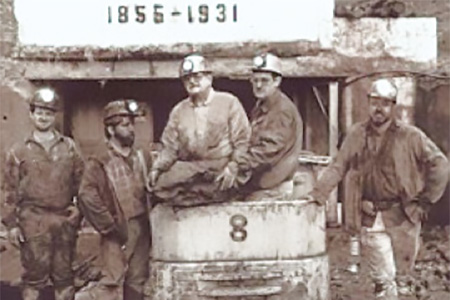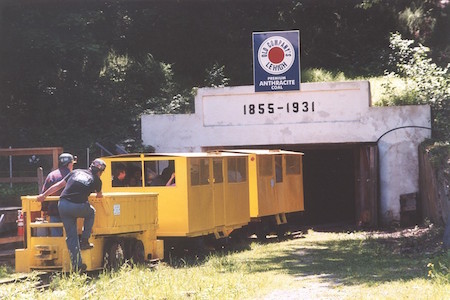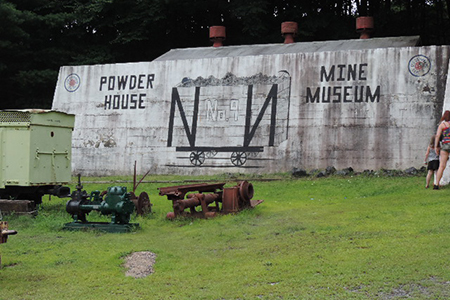
School
At the No. 9 Coal Mine & Museum, students can enjoy an hour-long documentary on the Anthracite Era and the Industrial Revolution. The museum offers questionnaires, available upon request, which contain discussion and fill-in-the-blank questions to help students learn from their experience at the museum (best for students in 3rd-12th grade). Special group tours, rates, and dates are available with a reservation for groups of 20 or more. Two-week advance notice is preferred.
supports classroom learning in:
Science, Social Studies.
topics covered:
American History, History, Geology, Engineering, Industrial Revolution, Industry, Technology.
contact info
Name: Zachary Petroski
Phone: 570-645-7074
INFO
ABOUT
No. 9 Coal Mine & Museum
Celebrate over 160 years of coal mining history at the No. 9 Mine! Take a 1,600-foot train ride into the mountain, then walk 600 feet on a guided tour of the oldest continuously operated deep anthracite coal mine in the world. View authentic equipment in a working environment dating back to 1855. The "Wash Shanty" Museum houses the gift shop as well as the largest mining artifact collection in the area.
contact info
Hrs: Vary, See website.
HELPFUL LESSON PLAN(S)
Prepared by FieldTripDirectory.com
Cave & Mine Lesson Plan
FUN FACTS
In history, caves have been used as shelter, as canvases for cave paintings, for rituals, and for food and weapons storage. In addition to historical relevance, caves also have unique geological features. On your tour be on the lookout for crystals, pools of water, stalagmites, and stalactites.
Mines are filled with useful materials that we use today. Coal is used to create electricity. Gold is used in the making of computers and jewelry. Limestone is used to make sidewalks and statues and monuments. Gypsum is used to make wallboards and plaster which is used in the construction of homes. Ask your tour guides about what the processes are like for mining each of these resources. How long does it take? What do each of these look like in their raw state?
View Lesson Plan>>
Scouts
At the No. 9 Coal Mine & Museum, scout groups can learn about coal mining through artifacts such as miners’ tools and equipment, photographs, models, and more. Tours are guided, providing groups with a better understanding of the work that went on in the mine. Special group tours, rates, and dates are available with a reservation for groups of 20 or more. Two-week advance notice is preferred.
supports scout badges in:
Science, Social Studies.
topics covered:
American History, History, Geology, Engineering, Industrial Revolution, Industry, Technology.
contact info
Name: Zachary Petroski.
Phone: 570-645-7074
INFO
ABOUT
No. 9 Coal Mine & Museum
Celebrate over 160 years of coal mining history at the No. 9 Mine! Take a 1,600-foot train ride into the mountain, then walk 600 feet on a guided tour of the oldest continuously operated deep anthracite coal mine in the world. View authentic equipment in a working environment dating back to 1855. The "Wash Shanty" Museum houses the gift shop as well as the largest mining artifact collection in the area.
contact info
Hrs: Vary, See website.
HELPFUL LESSON PLAN(S)
Prepared by FieldTripDirectory.com
Cave & Mine Lesson Plan
FUN FACTS
In history, caves have been used as shelter, as canvases for cave paintings, for rituals, and for food and weapons storage. In addition to historical relevance, caves also have unique geological features. On your tour be on the lookout for crystals, pools of water, stalagmites, and stalactites.
Mines are filled with useful materials that we use today. Coal is used to create electricity. Gold is used in the making of computers and jewelry. Limestone is used to make sidewalks and statues and monuments. Gypsum is used to make wallboards and plaster which is used in the construction of homes. Ask your tour guides about what the processes are like for mining each of these resources. How long does it take? What do each of these look like in their raw state?
View Lesson Plan>>
Camp
At the No. 9 Coal Mine & Museum, summer camp groups can enjoy an hour-long documentary on the Anthracite Era and the Industrial Revolution. The museum offers questionnaires, available upon request, which contain discussion and fill-in-the-blank questions to help them learn from their experience at the museum (best for 3rd-12th grade). Special group tours, rates, and dates are available with a reservation for groups of 20 or more. Two-week advance notice is preferred.
topics covered:
American History, History, Geology, Engineering, Industrial Revolution, Industry, Technology.
contact info
Name: Zachary Petroski.
Phone: 570-645-7074
INFO
ABOUT
No. 9 Coal Mine & Museum
Celebrate over 160 years of coal mining history at the No. 9 Mine! Take a 1,600-foot train ride into the mountain, then walk 600 feet on a guided tour of the oldest continuously operated deep anthracite coal mine in the world. View authentic equipment in a working environment dating back to 1855. The "Wash Shanty" Museum houses the gift shop as well as the largest mining artifact collection in the area.
contact info
Hrs: Vary, See website.
HELPFUL LESSON PLAN(S)
Prepared by FieldTripDirectory.com
Cave & Mine Lesson Plan
FUN FACTS
In history, caves have been used as shelter, as canvases for cave paintings, for rituals, and for food and weapons storage. In addition to historical relevance, caves also have unique geological features. On your tour be on the lookout for crystals, pools of water, stalagmites, and stalactites.
Mines are filled with useful materials that we use today. Coal is used to create electricity. Gold is used in the making of computers and jewelry. Limestone is used to make sidewalks and statues and monuments. Gypsum is used to make wallboards and plaster which is used in the construction of homes. Ask your tour guides about what the processes are like for mining each of these resources. How long does it take? What do each of these look like in their raw state?
View Lesson Plan>>
Homeschool
At the No. 9 Coal Mine & Museum, homeschoolers can enjoy an hour-long documentary on the Anthracite Era and the Industrial Revolution. The museum offers questionnaires, available upon request, which contain discussion and fill-in-the-blank questions to help them learn from their experience at the museum (best for 3rd-12th grade). Special group tours, rates, and dates are available with a reservation for groups of 20 or more. Two-week advance notice is preferred.
topics covered:
American History, History, Geology, Engineering, Industrial Revolution, Industry, Technology.
contact info
Name: Zachary Petroski.
Phone: 570-645-7074
INFO
ABOUT
No. 9 Coal Mine & Museum
Celebrate over 160 years of coal mining history at the No. 9 Mine! Take a 1,600-foot train ride into the mountain, then walk 600 feet on a guided tour of the oldest continuously operated deep anthracite coal mine in the world. View authentic equipment in a working environment dating back to 1855. The "Wash Shanty" Museum houses the gift shop as well as the largest mining artifact collection in the area.
contact info
Hrs: Vary, See website.
HELPFUL LESSON PLAN(S)
Prepared by FieldTripDirectory.com
Cave & Mine Lesson Plan
FUN FACTS
In history, caves have been used as shelter, as canvases for cave paintings, for rituals, and for food and weapons storage. In addition to historical relevance, caves also have unique geological features. On your tour be on the lookout for crystals, pools of water, stalagmites, and stalactites.
Mines are filled with useful materials that we use today. Coal is used to create electricity. Gold is used in the making of computers and jewelry. Limestone is used to make sidewalks and statues and monuments. Gypsum is used to make wallboards and plaster which is used in the construction of homes. Ask your tour guides about what the processes are like for mining each of these resources. How long does it take? What do each of these look like in their raw state?
View Lesson Plan>>
Family
Discover the fascinating history of coal mining with your family at the No. 9 Coal Mine & Museum. Families can take a guided tour of the historic mine and then visit the museum packed with mining artifacts. This is a unique chance to go inside of a genuine coal mine and learn about how anthracite mining helped build the U.S.A. The No. 9 Coal Mine and Museum offers special events throughout the year, details on their website. They also have a gift shop full of gorgeous hand-sculpted coal souvenirs, books, t-shirts, and more.
topics covered:
American History, History, Geology, Engineering, Industrial Revolution, Industry, Technology.
contact info
Phone: 570-645-7074
Email: [email protected]
INFO
ABOUT
No. 9 Coal Mine & Museum
Celebrate over 160 years of coal mining history at the No. 9 Mine! Take a 1,600-foot train ride into the mountain, then walk 600 feet on a guided tour of the oldest continuously operated deep anthracite coal mine in the world. View authentic equipment in a working environment dating back to 1855. The "Wash Shanty" Museum houses the gift shop as well as the largest mining artifact collection in the area.
contact info
Hrs: Vary, See website.
HELPFUL LESSON PLAN(S)
Prepared by FieldTripDirectory.com
Cave & Mine Lesson Plan
FUN FACTS
In history, caves have been used as shelter, as canvases for cave paintings, for rituals, and for food and weapons storage. In addition to historical relevance, caves also have unique geological features. On your tour be on the lookout for crystals, pools of water, stalagmites, and stalactites.
Mines are filled with useful materials that we use today. Coal is used to create electricity. Gold is used in the making of computers and jewelry. Limestone is used to make sidewalks and statues and monuments. Gypsum is used to make wallboards and plaster which is used in the construction of homes. Ask your tour guides about what the processes are like for mining each of these resources. How long does it take? What do each of these look like in their raw state?
View Lesson Plan>>
